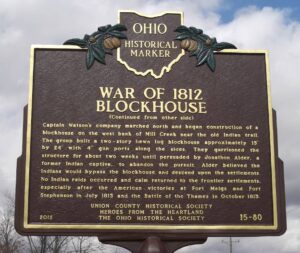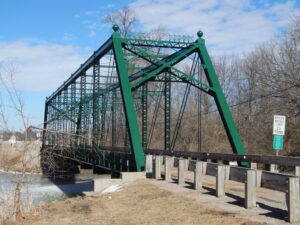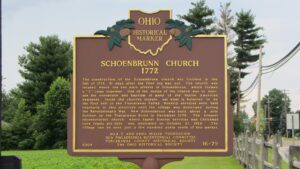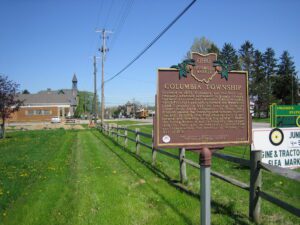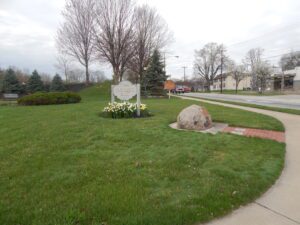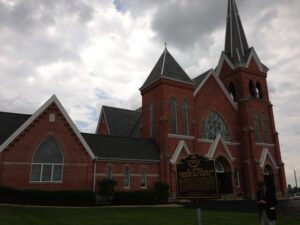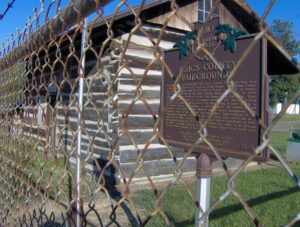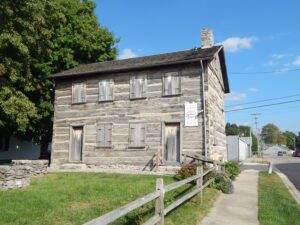, OH
Following the American surrender of Fort Detroit in August 1812, panic spread along the Ohio frontier in fear of possible Indian attacks. The boundary of the Indian territory lay approximately 14 miles to the north at the Greenville Treaty line. Ohio Governor Return Jonathan Meigs, Jr. called out the Ohio Militia to defend the frontier and to construct blockhouses to guard against Indian attacks. A local militia company of 70 men was raised in present Union and Madison Counties to protect the settlements along Big Darby Creek. David Watson served as captain with Frederick Lloyd as first lieutenant.
, OH
The Bridgeport Iron Bridge, often called the Streng Road Iron Bridge, was built in 1914. It replaced a wooden covered bridge built in 1869 by Reuben L. Partridge (1823-1900) and Isaac J. Grummons (1828-1921), which was damaged by the flood of 1913. The 200′ steel superstructure uses a pin-connected Pratt Through truss design and was constructed by the Central Concrete & Construction Company, Canton, Ohio, at a cost of $8,987. The original substructure abutments were constructed by John A. Maugans (1861-1933) for $3,248, but have since been replaced. In 1992 and 1993, the bridge was renovated under the leadership of County Engineer Steve A. Stolte and Assistant Engineer Jeff Stauch.
, OH
In December 1772, Brother David Zeisberger and his followers began the construction of Schoenbrunn schoolhouse. The school was built in the Tuscarawas Valley on land given to Zeisberger in the spring of 1771 by the Delaware Native Americans as a Moravian mission to the Delaware. With the land, Zeisberger laid out the town of Schoenbrunn or “Beautiful Spring.” The school served Delaware Indian children, who were taught from special textbooks prepared in the Delaware and German languages by Zeisberger. John Heckewelder, who taught at the school, is recognized as the first schoolteacher in Tuscarawas County. The present reconstructed schoolhouse was dedicated on July 29, 1928 on the 155th anniversary of the completion of the school’s construction. The village can be seen just a few hundred yards south of this marker.
, OH
Founded in 1807, Columbia was the first continuously inhabited settlement in Lorain County. Harmon, Levi and Azor Bronson, Calvin Hoadley, Jared Pritchard and others formed the Waterbury Land Company to buy the township from the Connecticut Land Company. In 1808, Sally Bronson named the township and became its first teacher. In 1809, the first church society was formed and Hoadley built a log gristmill beside the Rocky River. A militia company was organized in 1810 and a two-story blockhouse was constructed for protection during the War of 1812.
, OH
Trenton’s founder, Michael Pearce, came to the area in 1801. The original village of 33 lots was named Bloomfield. When the post office was established in 1820, it was named Trenton to honor the founder’s home state of New Jersey. Pearce’s son-in-law, Squier Littell, was the first resident doctor in Butler County. Originally settled by the English, Trenton saw a migration of Germans by 1840. By 1851, the farming community became a grain center with the introduction of the Cincinnati, Hamilton, and Dayton Railroad. Further development occurred when a franchise was granted to operate interurban electric traction cars through the village in 1896. Early commercial endeavors were Dietz, Good & Company grain elevator, Trenton Foundry, and Magnode Corporation. By 1991, the largest industries were Miller Brewing Company and Cinergy/Cincinnati Gas & Electric.
, OH
St. John’s Evangelical Lutheran Church was organized in 1838 by German Lutheran immigrants, primarily from Bavaria and Hesse-Darmstadt, who located in this vicinity in the 1830s. The congregation, called Neudettelsau, erected a second log church in 1843 centrally located in the “German Settlement”. A congregational split in 1846 resulted in the conservative members building a separate brick church a half mile away. This church in 1847 became one of the 12 charter members of the Lutheran Church-Missouri Synod. Growing membership required a larger brick church built on this site in 1860. In 1878 the two St. John’s congregations in the settlement reunited.
, OH
Situated in an agriculturally rich area, county fairs have long been a significant tradition and event in Meigs County. The Meigs County Agricultural Society held its first fair on October 22, 1851, in Middleport and its second at the Rock-Spring Hotel on October 31, 1852. Subsequent fairs occurred around the county until March 14, 1868, when the first section of a permanent location was purchased from Leonard and Jane Carleton near Rock Springs and became known as the Meigs County Fairgrounds. A popular place, the nearby natural springs, exemplified by the historic stone-carved springhouse, once supplied water to the grounds and community. Improvements to the fairgrounds included expanding the one-third mile racetrack to a half-mile in 1889, constructing the unique curved grandstand in 1890, and reconstructing the 1829 Foster-Jenkinson log cabin on the grounds in 1987. A single barrack from the Civilian Conservation Corps camp of the 1930s remains in use.
, OH
On this site Daniel Gebhart established a tavern in 1811. Taverns were where people gathered to eat, rest, and share news. During spring freshets, boatmen from the Great Miami River stayed at the tavern. Joining them were pioneers coming by the river and overland to settle at Hole’s Station, now Miamisburg. The tavern closed in 1840, became a boarding house, and then sold to become a private residence in 1853. To commemorate the nation’s Bicentennial in 1976, Miamisburg’s bicentennial committee purchased the tavern and gave it to the city. It was restored and opened as a museum in 1982. (Continued on other side)


